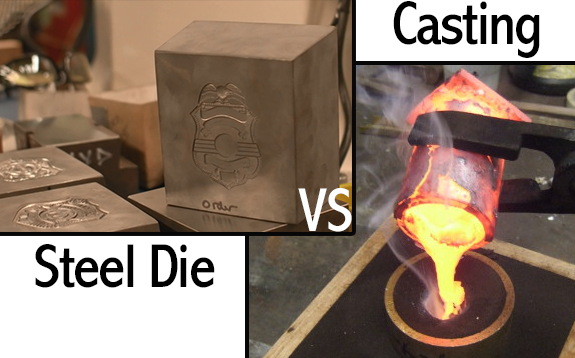The Top 5 Differences Between A Die Struck Badge And One Made From A Casting
Many folks wear badges, but few understand the process of making a police or fire badge. In this post we highlight the two most common methods of creating a badge; casting and striking with a steel die. Here we compare and contrast providing you with the top 5 differences between a die struck badge and one made from casting.
- We start at the beginning with the base metal which is formed into the shape of the badge, essentially the badges backbone
CASTING: In casting there are three metals generally used: Brass, Bronze, and Zinc – which are melted down and poured into a mold.
DIE: Conversely a die stamped badge is created from a solid durable base material like Hi-Glo, Rho-Glo, Nickel, etc. – the base material is not melted down the thick gauge metal is softened and stamped. - Forming the shape of the badge involves two very different processes. Since the processes affect the durability of the finished badge you should make sure to ask how your metal badge is created.
CASTING: A casting is created from molten metal poured into a mold which contains a hollow cavity made in the shape of the badge you desire. Because the composition of the base metal is broken down during the melting process the final product is weaker compared to that of a die created badge. Also, brass and bronze casting have poor detail quality where as a die cut badge has crisp lines capturing every subtle detail of the design.
DIE: The base metal is stamped using a hydraulic press holding a steel die that drops 600 tons of force onto a 5 ounce piece of raw metal. The steel die has a reverse relief of the badge design cut into it. The metal is hit by the hydraulic press between 3 and 12 times depending upon individual design requirements. The pressure squeezes the metal into the shape and form of the die. - Heat is a very important element used in the creation of a badge not only in forming its shape, but there are finishing processes that require heat. If a badge cannot withstand high temperatures the finishing processes will be negatively affected.
CASTING: A zinc casting, due to its low melting temperatures, cannot be hard enameled, because hard enamel is fired in 1400 degree ovens. Also, attachments have to be soft soldered, or fusion welded onto the back of the badge. These operations create a weak bond drawing durability into question.
DIE: A die struck badge can withstand the high oven temperatures used for hard enamel, also the attachment is adhered using electronic fusion and baking them in the oven for a permanent solder bond between the badge and attachment. - Size matters and it should be consistent from one badge to the next.
CASTING: Due to the casting process shrinkage occurs in the production of a badge, which produces roughly 2-3% variations in the overall shape of the badge.
DIE: A die cut badge is cut from the same die each time, the metal is pressed not melted and then trimmed using the same trimming tools each time, so the size of the badge never fluctuates. - Badge consistency is important to most departments, not only when it comes to the size of a badge but as it applies to the color/finish of the badge.
CASTING: There are six variations of bronze casting grain alloy material used in the casting process which can affect the visual shade of the raw bronze, so each badge run could produce a fluctuation in the shade of the badge (lighter or darker).DIE: A die cut badge is created from one base metal with no other alloys mixed in that could affect the overall color or strength of the badge. A finished badge is electroplated with a deposit of gold or other precious metal over the base metal, offering another layer of durability to your badge. The higher end base meals like HI-Glo and Rho-Glo require no plating they are highly polished and then a clear coating is applied to the badge to enhance its durability.
Because the badge is such an iconic symbol for public safety professionals it is important to ensure the badge that is being pinned on is one that will last, and stand up to the rigors of the job. At Blackinton all of our badges are made in our Massachusetts factory using steel dies.
If you would like to learn more about the process of making a die struck badge we encourage you to watch our video series #BadgeBuild which consists of nine short videos. We follow the journey of a piece of metal through our factory and watch as this metal is transformed into a piece of art – a police badge!

